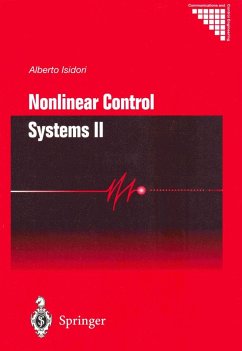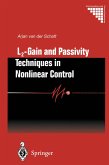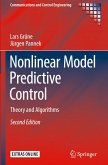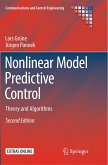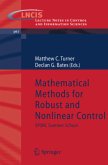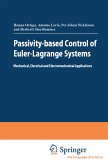The purpose of this book is to present a self-contained and coordinated de scription of several design methods for nonlinear control systems, with special emphasis on the problem of achieving stability, globally or on arbitrarily large domains, in the presence of model uncertainties. The book is intended to be a continuation of my earlier book Nonlinear Control Systems, dealing with the fundamentals of the theory of nonlinear control systems, whose third edition was published in 1995. In this respect, it is written in the form of a "second volume" of a single work, and uses a numbering system that continues the one adopted in the earlier book, with which the overlap is essentially insignificant. The book is intended as a graduate text as well as a reference to scientists and engineers interested in the design of feedback laws for nonlinear control systems. In the last decade, methods for global stabilization of nonlinear systems have experienced a vigorous growth.
Hinweis: Dieser Artikel kann nur an eine deutsche Lieferadresse ausgeliefert werden.
Hinweis: Dieser Artikel kann nur an eine deutsche Lieferadresse ausgeliefert werden.
From the reviews:
According to the Preface: "The purpose of this book is to present a self-contained and coordinated description of several design methods for nonlinear systems, with special emphasis on the problem of achieving stability, globally or on arbitrarily large domains, in the presence of model uncertainties. The book is intended to be a continuation of my earlier book [Nonlinear Control Systems, third edition, Springer, London, 1995]."
This statement provides an indication of the author's motivation and the emphasis of the presentation. The book provides a careful and detailed treatment of the selected topics.
It should be mentioned that intimate knowledge of Isidori's earlier book is not a prerequisite for the current book. Some references are made to the earlier book, but only relatively simple notions of relative degree and feedback transformations are used. Although the numbering scheme of the current book indicates a continuation of the earlier book, the topics covered are distinct and the two books can be studied independently.
Chapter 10 (the first chapter of the book) is devoted to the stability analysis of systems that can be viewed as a cascade or feedback interconnection. Basic analysis tools are introduced, including input-to-state stability, small gain theorem, dissipativity and passivity. Chapter 11 describes methods for global robust stabilization of nonlinear systems. Systems modelled by equations in lower-triangular form containing unknown parameters are introduced. Several control design approaches, based on different assumptions, are developed. Chapter 12 is concerned with "semi-global practical stabilizability". The case of output feedback is given considerable attention. In Chapter 13, the small-gain theorem is used to study robust stabilization in the presence of unmodeled dynamics. This leads to nonlinear H-infinity problems. Chapter 15 treats problems of stabilizability subject tocontrol amplitude constraints: several different approaches are developed. The book concludes with useful bibliographical notes and a list of references that the author has personally used in the development of the book.
The book does an excellent job of pulling together results from numerous research publications and presenting them in a reasonably unified form. The emphasis throughout is on the mathematical development, rather than on t he scientific significance of application of the concepts. Proofs are given for all major results, and in some cases several alternate proofs are provided. Many of the topics introduced remain the subject of active research, so that the book is likely to be of great interest to mathematicians, engineers, and scientists who are, or intend to become, active researchers in robust and global/semiglobal stabilization of nonlinear systems.
Mathematical Reviews m (2000) (Reviewer: N. Harris McClamroch)
This book is essential for serious research in nonlinear control, but requires some seriousness of purpose on the part of the reader.
International Journal of Robust and Nonlinear Control 13 (2003) 91 (Reviewer: David L. Elliott)
According to the Preface: "The purpose of this book is to present a self-contained and coordinated description of several design methods for nonlinear systems, with special emphasis on the problem of achieving stability, globally or on arbitrarily large domains, in the presence of model uncertainties. The book is intended to be a continuation of my earlier book [Nonlinear Control Systems, third edition, Springer, London, 1995]."
This statement provides an indication of the author's motivation and the emphasis of the presentation. The book provides a careful and detailed treatment of the selected topics.
It should be mentioned that intimate knowledge of Isidori's earlier book is not a prerequisite for the current book. Some references are made to the earlier book, but only relatively simple notions of relative degree and feedback transformations are used. Although the numbering scheme of the current book indicates a continuation of the earlier book, the topics covered are distinct and the two books can be studied independently.
Chapter 10 (the first chapter of the book) is devoted to the stability analysis of systems that can be viewed as a cascade or feedback interconnection. Basic analysis tools are introduced, including input-to-state stability, small gain theorem, dissipativity and passivity. Chapter 11 describes methods for global robust stabilization of nonlinear systems. Systems modelled by equations in lower-triangular form containing unknown parameters are introduced. Several control design approaches, based on different assumptions, are developed. Chapter 12 is concerned with "semi-global practical stabilizability". The case of output feedback is given considerable attention. In Chapter 13, the small-gain theorem is used to study robust stabilization in the presence of unmodeled dynamics. This leads to nonlinear H-infinity problems. Chapter 15 treats problems of stabilizability subject tocontrol amplitude constraints: several different approaches are developed. The book concludes with useful bibliographical notes and a list of references that the author has personally used in the development of the book.
The book does an excellent job of pulling together results from numerous research publications and presenting them in a reasonably unified form. The emphasis throughout is on the mathematical development, rather than on t he scientific significance of application of the concepts. Proofs are given for all major results, and in some cases several alternate proofs are provided. Many of the topics introduced remain the subject of active research, so that the book is likely to be of great interest to mathematicians, engineers, and scientists who are, or intend to become, active researchers in robust and global/semiglobal stabilization of nonlinear systems.
Mathematical Reviews m (2000) (Reviewer: N. Harris McClamroch)
This book is essential for serious research in nonlinear control, but requires some seriousness of purpose on the part of the reader.
International Journal of Robust and Nonlinear Control 13 (2003) 91 (Reviewer: David L. Elliott)

